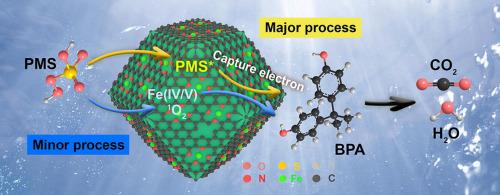Chemical Engineering Journal ( IF 13.3 ) Pub Date : 2021-04-06 , DOI: 10.1016/j.cej.2021.129590 Ting Yang , Shisuo Fan , Yang Li , Qi Zhou

|
A high-efficient iron-based heterogeneous catalyst is desired to active peroxymonosulfate (PMS). Due to a large catalytic contribution of atomically dispersed Fe-Nx sites, single-atom iron-nitrogen-carbon catalysts exhibit superior performance in the catalytic activation of PMS. Herein, a sequence of Fe-N-C SACs with atomically dispersed Fe-Nx sites, FeSA-N-C and FeSA-N/C, were prepared from Fe-doped ZIF-8 and FePc@ZIF-8, respectively. Single-atom Fe-Nx sites were confirmed to be the main active sites for PMS activation. FeSA-N/C-20 with a higher density of Fe-Nx sites exhibited superior catalytic performance to N/C, FeSA-N-C, FeSA-N/C-15, and FeSA-N/C-25 for BPA degradation. Integrated with chemical quenching experiments, electron spin resonance (ESR), in-situ Raman spectra, and electrochemical analysis, a nonradical pathway was demonstrated to dominate the degradation of BPA in the PMS + FeSA-N/C-20 system. More importantly, the nature of this nonradical pathway was found to be an electron-transfer regime instead of a high-valent iron or singlet oxygenation process. The BPA was adsorbed onto the Fe-Nx site by a “donor-acceptor complex” mechanism to form a nonradical PMS* intermediate during the process. Benefiting from this mechanism, the PMS + FeSA-N/C-20 system showed wide pH adaptation and high resistance to inorganic anions.
中文翻译:

Fe-N / C单原子催化剂,具有高密度的Fe-N x位向过氧单硫酸盐活化,可有效氧化双酚A:电子转移机理
需要高效率的铁基非均相催化剂来活化过氧单硫酸盐(PMS)。由于原子分散的Fe-N x部位具有很大的催化作用,因此单原子铁-氮-碳催化剂在PMS的催化活化中表现出优异的性能。在此,分别从掺杂Fe的ZIF-8和FePc @ ZIF-8制备具有原子分散的Fe-N x位点的Fe-NC SAC序列,即Fe SA -NC和Fe SA -N / C。证实单原子Fe-N x位点是PMS激活的主要活性位点。Fe - Nx位点密度较高的Fe SA -N / C-20的催化性能优于N / C,Fe SA -NC,FeSA -N / C-15和Fe SA -N / C-25用于BPA降解。与化学猝灭实验,电子自旋共振(ESR),原位拉曼光谱和电化学分析相结合,在PMS + Fe SA -N / C-20系统中,非自由基途径被证明是BPA降解的主要因素。更重要的是,发现这种非自由基途径的性质是电子转移机制,而不是高价铁或单线态氧合过程。在此过程中,BPA通过“供体-受体复合物”机制吸附在Fe-N x位点上,形成非自由基PMS *中间体。得益于此机制,PMS + Fe SA -N / C-20系统显示出广泛的pH适应性和对无机阴离子的高耐受性。

































 京公网安备 11010802027423号
京公网安备 11010802027423号